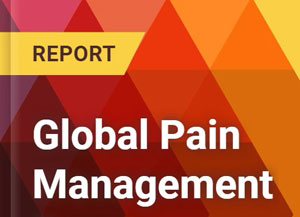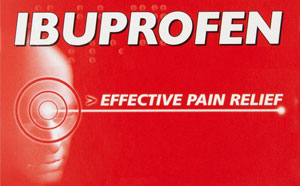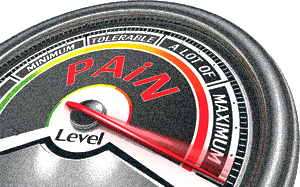
Pain - an unpleasant sensory and emotional experience associated with actual or potential tissue damage or described in terms of such damage.
Pain Medicines
There is a wide range of medicines available to treat the various types, intensities, and categories of pain. Pain medications are often the first course of treatment in pain management. Recently, there has been a rapid increase in the number and types of pain medications. Pain can be acute or chronic. Pain is a signal from our body that something is not right. It can be due to a physical injury, some kind of disease, or emotional upset. Most types of physical pain can be treated with pain relievers. Pain intensity can be described as mild, moderate, or severe.
Pain relievers are generally available in three forms: oral, topical, and injection.
Oral pain medications. There are many forms of pain medications that are taken by mouth, pill or liquid form, and they each work differently and have unique benefits and potential risks. Some are available without prescription.
Topical pain medications. These products are applied to the skin and are intended to reduce localized pain, such as pain from a sore muscle or from an arthritic joint. Most are available without a prescription.
Injections. Pain relieving medication or anti-inflammatory medications can be injected directly to the source of the pain.
You may take a certain type of pain medication for your condition, or you may use a variety of medicines to control your pain. Whatever the case, be sure to use your medication only as directed. Many pain medications have drug interaction warnings, including several of those listed above. If you are taking multiple pain medications, be sure to inform your doctor so he can alert you to any potential complications.
Of course, using medications inappropriately or in combination with other medications, including illicit street drugs, or alcohol, can result in particularly serious health consequences. It is important to review all medications and health problems with your chronic pain patients. Being informed about the specific adverse effects associated with pain medications can increase the chances of avoiding severe health problems, and lead to a better treatment outcome for their pain.
Pain medicines are also called analgesics. Each kind of pain medicine has benefits and risks. Some types of pain respond better to one kind of medicine than to another kind. What takes away your pain might not work for someone else.
Types of Pain Medications
 An analgesic is a medicine that temporarily reduces or relieves pain. Analgesics can make short-term pain more tolerable, but do not eliminate the cause for the pain. There are two types of analgesics used to manage pain: non-opioid analgesics and opioid analgesics.
An analgesic is a medicine that temporarily reduces or relieves pain. Analgesics can make short-term pain more tolerable, but do not eliminate the cause for the pain. There are two types of analgesics used to manage pain: non-opioid analgesics and opioid analgesics.
Analgesics are used to treat mild or moderate pain, and can also be used to reduce temperature in fevers. Narcotic analgesics such as Ultram can be used alone or in combination with other analgesics for stronger pain, such as dental pain or migraines. Non-steroidal anti-inflammatory medicines are used to reduce pain associated with inflammation, such as sports injuries, and can also be used to relieve fever.
Nonsteroidal anti-inflammatory medicines are used to reduce pain and inflammation. These drugs are often the first choice for treating the pain and inflammation associated with conditions ranging from headaches to osteoarthritis. There is an upper limit to the effectiveness of these medications, and increasing the dosage beyond a certain point does not increase pain relief. Non-opioid analgesics are not habit-forming.
Chronic use of pain medications, like chronic use of any other medications, can have a variety of adverse effects that can become greater when they are used regularly or over an extended period of time. It is important to stress to patients to only take those medications prescribed by a qualified healthcare practitioner, and to take them as they are directed to be taken.
Safe use of pain relievers
 Pain medications are safe and effective when used as directed. However, misuse of these products can be extremely harmful and even deadly. Consumers who take pain relief medications must follow their health care professional's instructions carefully. If a measuring tool is provided with your medicine, use it as directed. Do not change the dose of your pain relief medication without talking to your doctor first. Also, pain medications should never be shared with anyone else. Only your health care professional can decide if a prescription pain medication is safe for someone.
Pain medications are safe and effective when used as directed. However, misuse of these products can be extremely harmful and even deadly. Consumers who take pain relief medications must follow their health care professional's instructions carefully. If a measuring tool is provided with your medicine, use it as directed. Do not change the dose of your pain relief medication without talking to your doctor first. Also, pain medications should never be shared with anyone else. Only your health care professional can decide if a prescription pain medication is safe for someone.
There are many different types of pain medications available to help treat people with chronic pain. Depending on the specific medication, they can be obtained by prescription or without. Pain medications provide an important component of most treatment plans intended to relieve suffering and enhance the quality of lives for many patients. As with most other medical treatments, they may also often have significant adverse effects. In some cases, especially with long-term use, a pain medication may cause more harm than good. For this reason, the risks of the decision to continue a certain medical therapy should always be weighed against its benefits, sometimes resulting in possible dose adjustments to minimize adverse effects, or in other cases discontinuation of the medicine altogether.
Pain is real and it's physical - there's no mistaking that. But pain is measured and specific to one person based on that person's perception of the pain, and that's why everyone's pain is different. Some people do not want to tell their doctor they are experiencing pain because they are scared it means the disease has worsened or spread. Others feel like pain is simply a part of living with disease and that they should not complain. Although these thoughts are understandable, there are many reasons pain occurs, and everybody has the right to live without pain.
Whether you've got a headache, arthritis or even a toothache, choosing a pain reliever can be a bit confusing, especially with so many types of over-the-counter options available. They each provide great benefits, but there are many things to consider before choosing which one to take.
12/01/2023
RizaFilm - Breakthrough in Migraine Treatment
Rizafilm, an innovative oral thin film technology, revolutionizes the treatment of acute migraines. Building upon the proven effectiveness of Maxalt, a well-known rizatriptan-based medication, Rizafilm offers a proprietary formulation of rizatriptan benzoate with enhanced benefits.
What sets Rizafilm apart? Unlike traditional tablets like Maxalt, Rizafilm's oral soluble film dissolves rapidly in the mouth, eliminating the need for water. This innovative approach is particularly beneficial for patients who experience nausea during migraines or have difficulty swallowing pills.

Developed by IntelGenx, pioneers in pharmaceutical film technology, Rizafilm represents the next generation of migraine treatments. It leverages the reliable efficacy of Maxalt while providing a more user-friendly and rapid-acting solution. Discover in our article how Rizafilm is reshaping migraine management and bringing new hope to sufferers worldwide. Read more about Rizafilm and its impact.
02/22/2023
Best medications for low back pain, according to new research
In fact, low back pain is the leading cause of years lived with disability globally. Low back pain is called "acute" when symptoms last between one and 12 weeks and "chronic" when the pain lasts three months or longer.
People often reach for over-the-counter pain medication to help. But which type of pain med is most effective?
A new study, published in the Journal of Orthopaedic Research, attempted to find out. The study looked at the following types of analgesics: aspirin; acetaminophen (Tylenol, Paracetamol and Panadol); and nonsteroidal anti-inflammatory drugs, called NSAIDs for short, of which there are many.
Some common NSAIDs are ibuprofen (Advil, Motrin, PediaCare); naproxen (Aleve, Naxen, Naprosyn, Stirlescent); and celecoxib (Celebrex, Elyxyb), which is not available over the counter. Researchers also included muscle relaxers in the study, which are not available without a prescription.

The study found the very best medication for acute lower back pain was a combination of an NSAID combined with a prescription muscle relaxer — that combo was effective in reducing pain and disability by the end of one week. Combining an NSAID with acetaminophen was associated with a greater improvement than taking an NSAID alone, the study found. The results of the study only apply to lower back pain that isn’t ongoing and chronic.
12/12/2022
Worldwide Pain Management Drugs Industry 2022 & Rise in Number of Cases of Chronic Disorders
The pain management drugs market is anticipated to grow owing to the rise in number of cases of chronic disorders coupled with the rising healthcare expenditure and government support worldwide. Furthermore, growing number of surgical procedures and the increasing geriatric population are also estimated to fuel the market growth. However, the availability of alternatives such as pain reliever devices are expected to negatively impact the market growth.

Increasing incidence rate of chronic disorders is expected to boost the demand for pain management drugs for the treatment of pain associated with these disorders. According to the Centers for Disease Control and Prevention, as of March 2022, in the United States, 6 out of 10 adults suffer from a chronic disease and 4 out of 10 adults suffer from 2 diseases or more. These diseases include cancer, heart diseases, stroke, chronic lung disease, diabetes, Alzheimer's disease, and chronic kidney disease. Most or all of these diseases are associated with pain. Hence the rise in the number of cases of chronic disorders are expected to fuel the market growth.
11/14/2021
Does COVID-19 cause muscle pain?
One out of three people who are ill with COVID-19 will have unusual muscle pains. Unusual muscle pains can be an early symptom of COVID-19, often appearing at the very start of the illness. Usually, it lasts for an average of two to three days but can take longer to go away the older you are. This is commonly up to four days for children, five days for adults aged 16-35, seven days for adults aged 35-65 and up to eight days for adults over 65.

Unfortunately, COVID-related muscle pains can sometimes last much longer, and are commonly reported in people with long COVID or post-COVID syndrome. Having unusual muscle pains can be very debilitating. It’s important to listen to your body and not push yourself into doing more than you’re able to. Make sure you give yourself enough time and rest to get better if your muscle pains are caused by COVID-19, which can take a week or more to go away.
Ibuprofen, control pain better and have fewer side effects than Codeine
06/28/2021
Nonsteroidal anti-inflammatory drugs (NSAIDs), such as ibuprofen, control pain better and have fewer side effects than codeine, a commonly prescribed opioid, when prescribed after outpatient surgery. Codeine is widely used for postoperative pain and is the most commonly prescribed opioid in Canada. However, codeine is associated with a number of side effects and potential abuse or dependence. Alternatives, such as NSAIDs, may help reduce opioid use in patients after dental and surgical procedures.

Researchers conducted a systematic review and meta-analysis of high-quality randomized controlled trials (RCTs) involving more than 5,000 adults to compare pain levels and safety of codeine-containing medications with NSAIDs. Patients taking NSAIDs had lower pain rates 12 hours after treatment than patients taking codeine. Patients randomized to NSAIDs after outpatient surgical procedures reported better pain scores, better overall scores, fewer side effects, and no difference in bleeding events compared with patients who received codeine.
Addressing pain without the opioids
03/10/2019
As the health care community moves away from opioids for pain management, a number of approaches may be set to fill the gap, according to a presentation at the 2019 Congress of Clinical Rheumatology West. There were addressed a host of topics pertaining to pain in rheumatology, from the relationship between disease and pain management to an overview of novel non-pharmacotherapeutic interventions.

As the health care community moves away from opioids for pain management, a number of approaches may be set to fill the gap. The question of efficacy also arose. How well do they really work for long-term pain management? Why are people stuck on these medications for years and years? Pain measurement parameters may also be insufficient and, thereby, complicate pain management. With this in mind, novel methods for scoring pain are emerging. The NIH PROMIS Pain Interference Scale, the Widespread Pain Index (WPI), and symptom severity score all may have utility. They are simple and can be deployed in clinics.
25/02/2019
Tax on pain would be cruel medicine
The tax threatens to raise prescription and insurance costs that are already too high. Last year the Legislature imposed a novel tax on opioids that explicitly prevented drug makers from passing the cost to consumers. The legislation was poorly conceived so poorly, in fact, that a federal judge ultimately declared it unconstitutional.

Now, the governor is back with a proposal that's worse: An opioid tax that explicitly allows drug makers to shift the cost to consumers. We can understand why taxing opioids so appeals. The tax would raise $ millions for a state facing a billions budget deficit, and it targets the pain-killing medications at the center of a devastating and costly epidemic of addiction. Opioid makers are easy and compelling bad guys, given how they so ruthlessly promoted the pain killers. Who could object to making Big Pharma pay for an epidemic it helped create?
USA doesn't tax prescription and over-the-counter drugs, and it shouldn't open that door. Once opioids are taxed, the temptation to tax other medicines will be strong and prescriptions and drug coverage many New Yorkers already struggle to afford could become more costly. For all the problems they've caused, opioids are still vital for the people they are intended to help. Why should consumers who use opioids legitimately, including the terminally ill and others suffering from debilitating pain, be forced to pay more?
A tax on opioids is essentially a tax on pain. None of this means the pharmaceutical industry behaved responsibly when it spent millions upon millions, including on lobbying and political donations, to ensure maximum public access to opioid drugs that makers knew were highly addictive and potentially dangerous. Opioids, of course, have proven to be massively profitable, and drug makers should certainly pay for the crisis that has followed. But USA is already pursuing a method to address the misdeeds of opioid makers. It is suing them, seeking damages and civil payments.
09/08/2017
New pain reliever may help combat opioid abuse
Scientists have discovered a powerful pain reliever that is effective in alleviating neuropathic pain, a discovery that could be instrumental in addressing the opioid abuse epidemic, one of the biggest public health challenges today.

In the study, the synthetic compound was found effective in relieving neuropathic pain. It was as effective as a drug widely used for pain relief called gabapentin.
The new pain drug binds to a receptor on cells throughout the central nervous system called the sigma 2 receptor. This opens the door to having a new treatment for neuropathic pain that is not an opioid. If the drug is proved to be safe, effective and non-addictive in humans, the discovery could be instrumental in addressing the opioid abuse epidemic, because, nearly two million people in the US suffer from addiction to prescription opioid pain relievers.